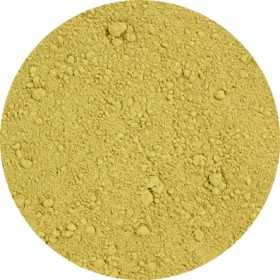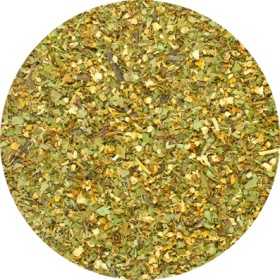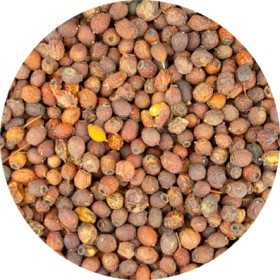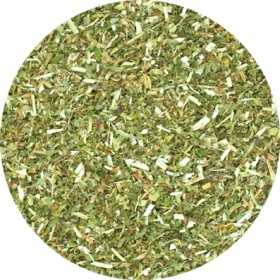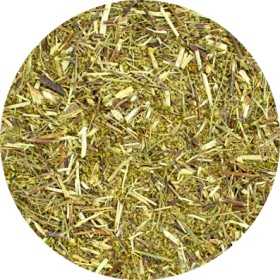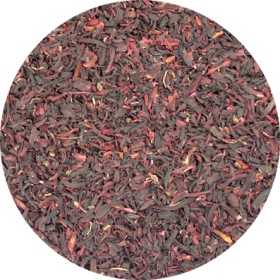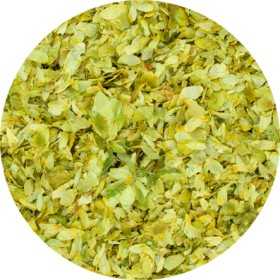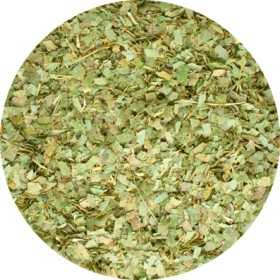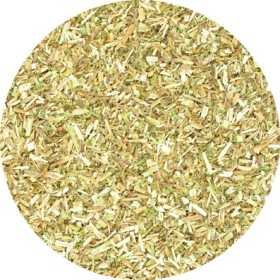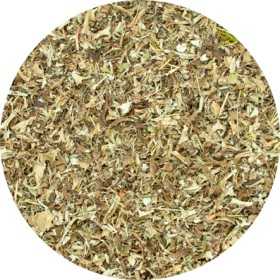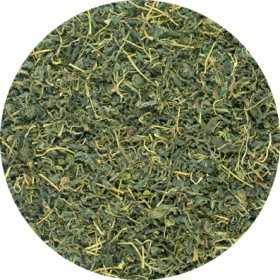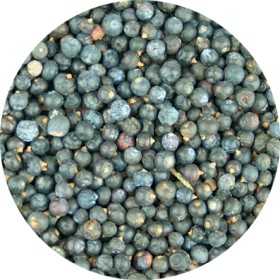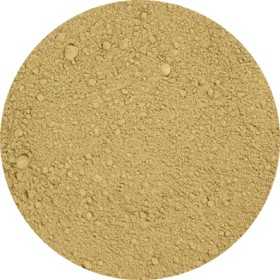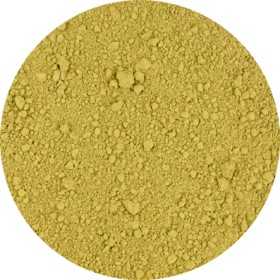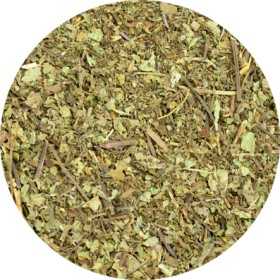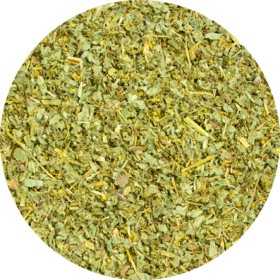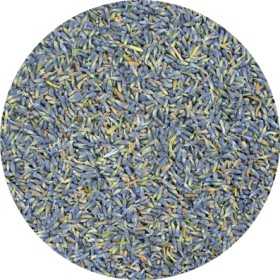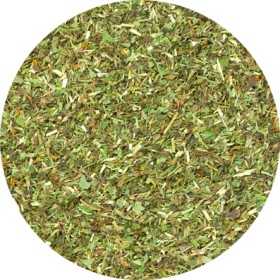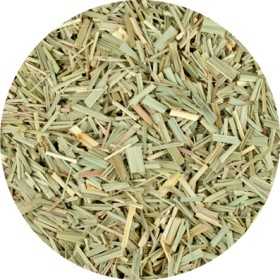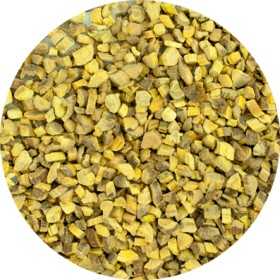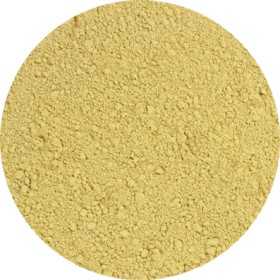Herbs
There are 208 products.
Hawthorn (Leaf & Flower) - Crataegus laevigata, Crataegi
The two-stemmed hawthorn (Crataegus laevigata) is a natural source of beneficial substances. The flowers, leaves and to a lesser extent the berries of the hawthorn contain a rich variety of components, including flavonoids, procyanidins, vitamin C, tannins, glycosides and antioxidants. These substances have beneficial effects on the heart and contribute to a healthy lifestyle. Hawthorn is known for its calming properties and supports natural, deep sleep.
€2.00
From: €2.00
Hawthorn (Leaf & Flower) Cut - Crataegus laevigata, Crataegi
The two-stemmed hawthorn (Crataegus laevigata) is a natural source of beneficial substances. The flowers, leaves and to a lesser extent the berries of the hawthorn contain a rich variety of components, including flavonoids, procyanidins, vitamin C, tannins, glycosides and antioxidants. These substances have beneficial effects on the heart and contribute to a healthy lifestyle. Hawthorn is known for its calming properties and supports natural, deep sleep.
€2.50
From: €2.50
Hawthorn berry - Crataegus monogyna (Crataegus oxycantha)
The hawthorn (Crataegus) is a natural source of beneficial substances. The flowers, leaves and to a lesser extent the berries of the hawthorn contain a rich variety of components, including flavonoids, procyanidins, vitamin C, tannins, glycosides and antioxidants. These substances have beneficial effects on the heart and contribute to a healthy lifestyle. Hawthorn is known for its calming properties and supports natural, deep sleep.
€2.00
From: €2.00
Heartwort - Leonurus cardiaca
Heartwort (Leonurus cardiaca) is a fragrant perennial plant that belongs to the Lamiaceae family. Originating in Central Asia, this plant has spread throughout the world.
The leaves are suitable for seasoning pea and lentil soup, and were also used in the past to brew beer. This plant has been used for centuries for its medicinal properties for heart problems and muscle cramps.
The plant grows to a height of 30-90 cm and forms rhizomes and square stems with scattered hairs. The leaves, which are medium green in color, have three to seven lobes and are downy hairy on the underside.
The leaves are suitable for seasoning pea and lentil soup, and were also used in the past to brew beer. This plant has been used for centuries for its medicinal properties for heart problems and muscle cramps.
The plant grows to a height of 30-90 cm and forms rhizomes and square stems with scattered hairs. The leaves, which are medium green in color, have three to seven lobes and are downy hairy on the underside.
€2.00
From: €2.00
Herb Royal - Artemisia abrotani
Herb Royal (Artemisia abrotanum) is a bushy shrub belonging to the composite family. The plant is originally native to southern Europe, but has been introduced to much more northern areas of Europe.
Historically, the Germanic people used Herb Royal to ward off druids and witches. The Romans made the perfume Abrotenum from it. In addition to its use as a perfume, lemon herb was also used to clean and deodorize wounds, treat cramps and asthma, and as a soothing balm.
Historically, the Germanic people used Herb Royal to ward off druids and witches. The Romans made the perfume Abrotenum from it. In addition to its use as a perfume, lemon herb was also used to clean and deodorize wounds, treat cramps and asthma, and as a soothing balm.
€2.40
From: €2.40
Hibiscus - Hibiscus sabdariff
The Hibiscus (Hibiscus sabdariffa) is traditionally used in hot and cold drinks, as a flavoring and coloring agent in the food industry, and as a herbal remedy for its ability to reduce fatigue and promote cardiovascular health.
Hibiscus sabdariffa L. is an annual shrub that can grow more than two meters high. The shrub usually has smooth, red stems and cream or pale yellow flowers that turn pink when they wilt at the end of the day. At that time, a characteristic red calyx grows, which is fleshy, crispy and juicy. This calyx turns brown and bursts open when it is dry and grown. The calyx, stems and leaves have a sour taste reminiscent of cranberries.
Hibiscus sabdariffa L. is an annual shrub that can grow more than two meters high. The shrub usually has smooth, red stems and cream or pale yellow flowers that turn pink when they wilt at the end of the day. At that time, a characteristic red calyx grows, which is fleshy, crispy and juicy. This calyx turns brown and bursts open when it is dry and grown. The calyx, stems and leaves have a sour taste reminiscent of cranberries.
€2.25
From: €2.25
Hop - Humulus lupulus
Hop (Humulus lupulus), also known as the "natural tranquilizer", may get its name from the Latin word lupus (wolf). It is traditionally used to promote sleep and is loved by menopausal women for its calming properties and support for regular menstrual cycles.
The beneficial properties of hops are due to a combination of polyphenols with phytoestrogenic effects, flavonoids, potassium salts, B vitamins and amino acids. It not only supports hormonal balance during menopause, but also helps with digestive problems and promotes healthy cholesterol levels.
The beneficial properties of hops are due to a combination of polyphenols with phytoestrogenic effects, flavonoids, potassium salts, B vitamins and amino acids. It not only supports hormonal balance during menopause, but also helps with digestive problems and promotes healthy cholesterol levels.
€2.95
From: €2.95
Horny Goat Herb - Yin Yang Huo - Epimedium brevicornum
Epimedium, commonly known as elf flower, is a genus of about 25 species of perennial plants belonging to the barberry family (Berberidaceae). These enchanting plants are native to southern Europe and parts of Asia, including central, southern and eastern Asia.
Interestingly, many species of Epimedium are said to have aphrodisiac properties. According to an ancient Chinese legend, this remarkable effect was discovered by a goat herder, who noticed that his animals became noticeably more active after eating these plants. This led to the plant being given the name 'yin yang huo' in China, which literally translates as 'Horny Goat Herb'.
Interestingly, many species of Epimedium are said to have aphrodisiac properties. According to an ancient Chinese legend, this remarkable effect was discovered by a goat herder, who noticed that his animals became noticeably more active after eating these plants. This led to the plant being given the name 'yin yang huo' in China, which literally translates as 'Horny Goat Herb'.
€9.95
From: €9.95
Hyssop - Hyssopus officinalis
Hyssop (Hyssopus officinalis) belongs to the Lamiaceae family and is an herb with valuable essential oils.
This striking shrub reaches a height of 30 to 60 cm and has a woody base with ascending branches. The dark green lanceolate leaves are about 2 to 2.5 cm long. During the flowering period, from July to September, hyssop produces small blue/lilac-like lipped flowers that grow in whorls, although some specimens may be white or pink.
This striking shrub reaches a height of 30 to 60 cm and has a woody base with ascending branches. The dark green lanceolate leaves are about 2 to 2.5 cm long. During the flowering period, from July to September, hyssop produces small blue/lilac-like lipped flowers that grow in whorls, although some specimens may be white or pink.
€1.95
From: €1.95
Iceland moss - Cetraria islandicus
Icelandic moss (Cetraria islandica, basionym: Lichen islandicus) is a shrubby lichen belonging to the Parmeliaceae family. This species is extremely rare in the Netherlands and is on the Dutch Red List as critically endangered.
A medicinal effect was attributed to the lichen. It was collected in its entirety for this purpose. Although not known medicinally in ancient times, it did not enter medicine until the 17th century. It was used for rashes, wounds, ulcers and various lung diseases such as bronchitis.
A medicinal effect was attributed to the lichen. It was collected in its entirety for this purpose. Although not known medicinally in ancient times, it did not enter medicine until the 17th century. It was used for rashes, wounds, ulcers and various lung diseases such as bronchitis.
€3.00
From: €3.00
Jiaogulan - Gynostemma pentaphyllum
Gynostemma pentaphyllum, also known as 'jiaogulan', is a climbing plant naturally occurring in Japan, southeastern China and Thailand. In the Netherlands this plant is known as 'immortality herb' or 'eternal life herb'. It has a prominent place in traditional Chinese herbal medicine. Rich in antioxidants, this herb supports normal liver function and helps maintain healthy blood sugar levels. It also has benefits for the heart, blood vessels and cholesterol levels.
€5.75
From: €5.75
Juniper Berries - Juniper communis
The juniper berry (Juniperus communis) is rich in vitamin C and antioxidants, which occur naturally in its berries. These antioxidants protect our body cells against harmful influences such as pollution and sunlight. In addition, they support digestion and contribute to healthy kidney function and fluid balance.
The juniper is a conifer native to Europe, Asia and America. This tree bears flowers and berries at the same time, which can be green and black. The name Juniperus is derived from the Celtic word 'juneprus', meaning rough, prickly or bitter, and 'communis' meaning plain. Since ancient times, the berries have been used by Greeks and Romans for their health benefits.
The juniper is a conifer native to Europe, Asia and America. This tree bears flowers and berries at the same time, which can be green and black. The name Juniperus is derived from the Celtic word 'juneprus', meaning rough, prickly or bitter, and 'communis' meaning plain. Since ancient times, the berries have been used by Greeks and Romans for their health benefits.
€2.60
From: €2.60
Juniper Berries - Juniper communis - Whole
The juniper berry (Juniperus communis) is rich in vitamin C and antioxidants, which occur naturally in its berries. These antioxidants protect our body cells against harmful influences such as pollution and sunlight. In addition, they support digestion and contribute to healthy kidney function and fluid balance.
The juniper is a conifer native to Europe, Asia and America. This tree bears flowers and berries at the same time, which can be green and black. The name Juniperus is derived from the Celtic word 'juneprus', meaning rough, prickly or bitter, and 'communis' meaning plain. Since ancient times, the berries have been used by Greeks and Romans for their health benefits.
The juniper is a conifer native to Europe, Asia and America. This tree bears flowers and berries at the same time, which can be green and black. The name Juniperus is derived from the Celtic word 'juneprus', meaning rough, prickly or bitter, and 'communis' meaning plain. Since ancient times, the berries have been used by Greeks and Romans for their health benefits.
€2.30
From: €2.30
Kelp - Vesiculosus Fucus
Kelp, a member of the brown algae (Laminariales) family, thrives in the cold waters of the major oceans. This large species of seaweed is an excellent source of iodine, an essential element for healthy thyroid function in humans.
In Asia, especially Japan, seaweed has been an integral part of the daily diet for centuries. A well-known kelp species is kombu (Laminaria japonica), which is often cooked with rice for sushi. In addition to being one of the largest plants in the world, kelp is known for growing extremely quickly, sometimes up to three meters per day.
In Asia, especially Japan, seaweed has been an integral part of the daily diet for centuries. A well-known kelp species is kombu (Laminaria japonica), which is often cooked with rice for sushi. In addition to being one of the largest plants in the world, kelp is known for growing extremely quickly, sometimes up to three meters per day.
€2.50
From: €2.50
Kumis Kutjing - Cat's whiskers - Orthosiphon aristatus
Cat's whisker (Orthosiphon aristatus), also known as Kumis Kutjing, has played an important role in Ayurvedic medicine for centuries due to its beneficial properties in treating urinary tract infections.
This plant belongs to the Lamiaceae family and thrives mainly in tropical and subtropical regions, preferring locations such as wetlands, along rivers and swamps, especially in Southeast Asia, especially Malaysia and Java. The name "cat's whisker" is derived from the white or lilac flowers with striking, thread-like stamens, sometimes up to 3 cm long.
This plant belongs to the Lamiaceae family and thrives mainly in tropical and subtropical regions, preferring locations such as wetlands, along rivers and swamps, especially in Southeast Asia, especially Malaysia and Java. The name "cat's whisker" is derived from the white or lilac flowers with striking, thread-like stamens, sometimes up to 3 cm long.
€2.30
From: €2.30
Kumis Kutjing - Cat's whiskers - Orthosiphon aristatus - Cut
Cat's whisker (Orthosiphon aristatus), also known as Kumis Kutjing, has played an important role in Ayurvedic medicine for centuries due to its beneficial properties in treating urinary tract infections.
This plant belongs to the Lamiaceae family and thrives mainly in tropical and subtropical regions, preferring locations such as wetlands, along rivers and swamps, especially in Southeast Asia, especially Malaysia and Java. The name "cat's whisker" is derived from the white or lilac flowers with striking, thread-like stamens, sometimes up to 3 cm long.
This plant belongs to the Lamiaceae family and thrives mainly in tropical and subtropical regions, preferring locations such as wetlands, along rivers and swamps, especially in Southeast Asia, especially Malaysia and Java. The name "cat's whisker" is derived from the white or lilac flowers with striking, thread-like stamens, sometimes up to 3 cm long.
€4.50
From: €4.50
Lady's Mantle - Alchemilla vulgaris
Lady's mantle (Alchemilla vulgaris) is a genus of about a thousand species of perennial herbaceous and shrubby plants belonging to the rose family (Rosaceae). It is mainly found in Europe and Asia, with some species in the mountainous areas of Africa, North and South America. Lady's mantles thrive in disturbed and usually damp places, such as forest edges, wet grasslands and roadsides.
€2.50
From: €2.50
Lavender - Lavendula angustifolia
Lavender (Lavandula) is a genus of dwarf shrubs belonging to the Lamiaceae family. These plants are often planted in gardens for their purple flowers and wonderful scent.
An important reason for growing lavender is the lavender oil extracted from the purple flowers. This oil is widely used as a fragrance in cosmetic products such as soap and perfume, and also in aromatherapy.
Lavender flowers are used in cooking, especially as part of Provencal herb mixtures. They can be used fresh or dried to flavor various dishes, such as French cheeses, carrots and tomatoes.
An important reason for growing lavender is the lavender oil extracted from the purple flowers. This oil is widely used as a fragrance in cosmetic products such as soap and perfume, and also in aromatherapy.
Lavender flowers are used in cooking, especially as part of Provencal herb mixtures. They can be used fresh or dried to flavor various dishes, such as French cheeses, carrots and tomatoes.
€5.00
From: €5.00
Lemon Balm - Melissa officinalis
Lemon balm (Melissa officinalis) is a perennial plant from the Lamiaceae family known for its lemony scent. This plant grows mainly in southern Europe, but can be easily propagated in temperate regions such as the Netherlands and Belgium, as it survives in winter via rhizomes. The plant reaches a height of about 0.5 meters.
Lemon balm has a long history; The plant was already known to various peoples 2000 years ago. The Arabs probably brought the plant to Europe via Spain, after which monasteries initially engaged in its cultivation. Ancient scriptures state that lemon balm leaves warm the stomach, aid digestion, dispel gloom and promote cheerful dreams. The leaves are often used in dishes, tea, oil or creams.
Lemon balm has a long history; The plant was already known to various peoples 2000 years ago. The Arabs probably brought the plant to Europe via Spain, after which monasteries initially engaged in its cultivation. Ancient scriptures state that lemon balm leaves warm the stomach, aid digestion, dispel gloom and promote cheerful dreams. The leaves are often used in dishes, tea, oil or creams.
€2.00
From: €2.00
Lemongrass - Cymbopogon citratus
Lemongrass, also known as sereh (Cymbopogon citratus), belongs to the grass family (Poaceae). This plant is widely used in Asian cuisine, especially in dishes from Thailand, India, Vietnam and Indonesia. Lemongrass thrives in several regions, including India, Africa, Vietnam, Australia and America. In Indonesia it is known as sereh, and this name is also often used in the Netherlands.
The leaves of the lemongrass plant are the culinary stars. They have a refreshing, lemony taste and are not consumed raw. Pieces of lemongrass are often added to dishes during cooking or stewing, after which they are removed before serving.
The leaves of the lemongrass plant are the culinary stars. They have a refreshing, lemony taste and are not consumed raw. Pieces of lemongrass are often added to dishes during cooking or stewing, after which they are removed before serving.
€2.00
From: €2.00
Licorice (Without Bark) - Glycyrrhiza glabra, Liquiritiae
Licorice (Glycyrrhiza glabra) is a versatile herb that plays an important role in Ayurvedic medicine. It is known for its beneficial effects on digestion and maintaining flexible joints, while also soothing the respiratory tract.
This plant is grown in various parts of the world, including Europe, Asia and the Middle East. It is a hardy plant that even thrives in the Netherlands. However, it takes three to four years before the roots can be harvested.
In addition to the roots, the leaves can also be used, for example to make tea. Licorice is widely used in foods and pharmaceuticals because of its sweet taste and other ingredients.
This plant is grown in various parts of the world, including Europe, Asia and the Middle East. It is a hardy plant that even thrives in the Netherlands. However, it takes three to four years before the roots can be harvested.
In addition to the roots, the leaves can also be used, for example to make tea. Licorice is widely used in foods and pharmaceuticals because of its sweet taste and other ingredients.
€2.25
From: €2.25
Licorice - Glycyrrhiza glabra, Liquiritiae
Licorice (Glycyrrhiza glabra) is a versatile herb that plays an important role in Ayurvedic medicine. It is known for its beneficial effects on digestion and maintaining flexible joints, while also soothing the respiratory tract.
This plant is grown in various parts of the world, including Europe, Asia and the Middle East. It is a hardy plant that even thrives in the Netherlands. However, it takes three to four years before the roots can be harvested.
In addition to the roots, the leaves can also be used, for example to make tea. Licorice is widely used in foods and pharmaceuticals because of its sweet taste and other ingredients.
This plant is grown in various parts of the world, including Europe, Asia and the Middle East. It is a hardy plant that even thrives in the Netherlands. However, it takes three to four years before the roots can be harvested.
In addition to the roots, the leaves can also be used, for example to make tea. Licorice is widely used in foods and pharmaceuticals because of its sweet taste and other ingredients.
€2.00
From: €2.00
Lijnzaad - Linum usitatissimum
Flaxseed is rich in omega-3 fatty acids, with an impressive 55% alpha-linolenic acid (ALA) content. It also contains tocopherols, carotenoids, minerals and lignans (phytosterols). Also, about 20% of its fatty acid is omega 9 (oleic acid). The Nutrition Center emphasizes the beneficial effects of omega-3 fatty acids on the heart and blood vessels. The flax plant (Linum usitatissimum), from which linseed is harvested, is distributed worldwide and humanity has used linseed since 7000 BC.
€2.00
From: €2.00
Lime tree Blossom - Tiliae officinalis
The lime tree (Tilia) is native to the Benelux and is known for its remarkable lifespan, which can easily exceed 1000 years. This majestic tree can reach a height of 20 to 30 meters, depending on its growing conditions. The Latin name for the lime tree is Tilia.
Although the lime tree is widespread in Europe, it is not found in the northernmost and southernmost parts of the continent. Outside Europe, the lime is also found in parts of Asia, but to a much lesser extent.
The tree blooms in the months of June and July. The lime blossom produces a lot of honey, and the flowers can be used to make herbal tea.
Although the lime tree is widespread in Europe, it is not found in the northernmost and southernmost parts of the continent. Outside Europe, the lime is also found in parts of Asia, but to a much lesser extent.
The tree blooms in the months of June and July. The lime blossom produces a lot of honey, and the flowers can be used to make herbal tea.
€5.00
From: €5.00















